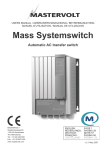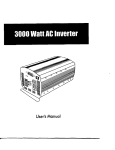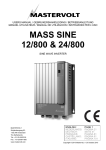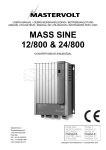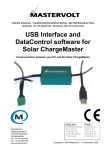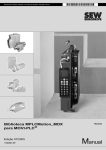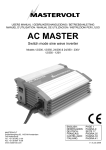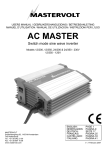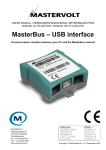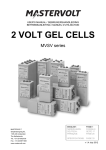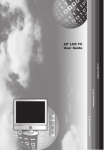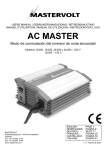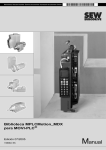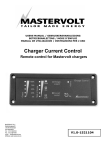Download manual - Motocraft
Transcript
USERS MANUAL / GEBRUIKERSHANDLEIDING / BETRIEBSANLEITING MODE D’EMPLOI / MANUAL DE UTILIZACION / INSTRUZIONI PER L’USO MASS SINE 12/800, 24/800 & 48/500 230V sine wave inverter MASTERVOLT Snijdersbergweg 93, 1105 AN Amsterdam The Netherlands Tel.: +31-20-3422100 Fax.: +31-20-6971006 www.mastervolt.com ENGLISH: NEDERLANDS: DEUTSCH: FRANÇAIS: ESPAÑOL: ITALIANO: PAGE 1 PAGINA 17 SEITE 33 PAGINA 49 PÁGINA 65 PAGINA 81 v 4.1. February 2006 CONTENTS CONTENTS: QUICK INSTALLATION INSTRUCTIONS................................................................................................................ 3 1 GENERAL INFORMATION............................................................................................................................. 4 1.1 Use of this manual .............................................................................................................................. 4 1.2 Guarantee specifications .................................................................................................................... 4 1.3 Quality................................................................................................................................................. 4 1.4 Validity of this manual......................................................................................................................... 4 1.5 Liability................................................................................................................................................ 4 1.6 Changes to the inverter ...................................................................................................................... 4 2 SAFETY QUIDELINES AND MEASURES ..................................................................................................... 5 2.1 Warnings and symbols ....................................................................................................................... 5 2.2 Use for intended purpose ................................................................................................................... 5 2.3 Oganizational measures ..................................................................................................................... 5 2.4 Maintenance & repair.......................................................................................................................... 5 2.5 Warning for specific dangers .............................................................................................................. 5 2.6 Warning regarding life support applications ....................................................................................... 5 3 INSTALLATION .............................................................................................................................................. 6 3.1 Environment........................................................................................................................................ 6 3.2 Wiring.................................................................................................................................................. 6 3.3 Unpacking........................................................................................................................................... 6 3.4 Tools required for installation ............................................................................................................. 6 3.5 Mounting of the cabinet ...................................................................................................................... 7 3.6 Connecting.......................................................................................................................................... 8 3.6.1 Removal of the front panel .................................................................................................. 8 3.6.2 Connecting the AC wiring and earth wiring......................................................................... 8 3.6.3 DC wiring............................................................................................................................. 8 3.6.4 Battery cable connections ................................................................................................... 8 3.7 Connecting the remote control panel.................................................................................................. 9 3.8 Commissioning after installation....................................................................................................... 10 3.9 Automatic switching between AC sources........................................................................................ 10 3.10 Decommissioning ............................................................................................................................. 10 3.11 Storage and transportation ............................................................................................................... 10 3.12 Low energy mode ............................................................................................................................. 10 3.12.1 Low power mode ............................................................................................................... 11 3.12.2 Economic mode................................................................................................................. 11 3.12.3 Stand-by mode .................................................................................................................. 11 4 OPERATION ................................................................................................................................................. 12 4.1 General ............................................................................................................................................. 12 4.2 Switching on and off ......................................................................................................................... 12 4.3 Indicator lights on the front of the inverter ........................................................................................ 12 4.4 The remote control............................................................................................................................ 13 4.5 Maintenance ..................................................................................................................................... 13 5 TROUBLE SHOOTING ................................................................................................................................. 14 6 TECHNICAL DATA....................................................................................................................................... 15 7 EC DECLARATION OF CONFIRMITY......................................................................................................... 16 2 February 2006 / Mass Sine 12-800, 24-800, 48-500 / EN QUICK INSTALLATION INSTRUCTIONS QUICK INSTALLATION INSTRUCTIONS 1 This section provides a brief overview of a basic installation of the Mass Sine inverter. However; please review the entire manual for connection of additional features and to ensure best performance and years of trouble-free service. 2 The electrical system must be disconnected from any power source during the entire installation! Use isolated tools! 3 Mount the inverter to a vertical surface. Allow at least 10 cm / 4 inch space around the apparatus! 5 Connect the AC load to the AC output. For safe installation it is necessary to: • Connect both the earth (PE/GND) and the neutral (N) of the AC output of the inverter to the central grounding point • Integrate a Residual Current Device (RCD) in wiring of the AC output Refer to local applicable regulations on these issues. N L AC LOAD RCD 6 4 Open the connection compartment; Steps: 1 Loosen the two Philips screws that secure the front cover plate for two turns. 2 Slide the front cover plate from the cabinet Connect the battery to the DC input. Integrate a fuse holder in the positive battery wire, but do not place the fuse yet. Connect positive wire to +, negative wire to –. Incorrect polarity will damage the inverter! Step 1 2x 7 Step 2 EN / Mass Sine 12-800, 24-800, 48-500 / February 2006 • Close the connection compartment. • Place the inverter fuse. • Switch on the inverter. 3 GENERAL INFORMATION 1 GENERAL INFORMATION 1.1 USE OF THIS MANUAL This manual serves as a guideline for safe and effective operation, maintenance and possible correction of minor malfunctions of the inverter. It is therefore obligatory that every person who works on or with the inverter must be completely familiar with the contents of this manual, and that he/she carefully follows the instruction contained herein. Installation of, and work on the inverter, may be carried out only by qualified, authorized and trained personnel, familiar with the locally applicable standards and taking into consideration the safety guidelines and measures (chapter 2 of this manual). Keep this manual at a secure place! This manual has 16 pages. 1.2 GUARANTEE SPECIFICATIONS Mastervolt guarantees that this unit has been built according to the legally applicable standards and specifications. Should work take place, which is not in accordance with the guidelines, instructions and specifications contained in this user's manual, then damage may occur and/or the unit may not fulfil its specifications. All of these matters may mean that the guarantee may become invalid. 1.3 QUALITY During their production and prior to their delivery, all of our units are exhaustively tested and inspected. The guarantee period is two years after date of purchase. 4 1.4 VALIDITY OF THIS MANUAL All of the specifications, provisions and instructions contained in this manual apply solely to the Mastervolt delivered standard versions of the MASS inverter. This manual is valid for the following models: Description MASS SINE 12/800 MASS SINE 24/800 MASS SINE 48/500 1.5 Part number 24010800 24020800 24040500 LIABILITY Mastervolt can accept no liability for: • consequential damage due to use of the inverter; • possible errors in the manuals and the results thereof. CAREFUL! Never remove the type number plate. Important technical information required for service, maintenance & secondary delivery of parts can be derived from the type number plate. 1.6 CHANGES TO THE INVERTER Modifications to the inverter may be carried out only after the written permission of Mastervolt. February 2006 / Mass Sine 12-800, 24-800, 48-500 / EN SAFETY QUIDELINES AND MEASURES 2 SAFETY QUIDELINES AND MEASURES 2.1 • WARNINGS AND SYMBOLS Safety instructions & warnings are marked in this manual by the following symbols: 2 CAREFUL! Special data, restrictions and rules with regard to preventing damage. 2.5 WARNING A WARNING refers to possible injury to the user or significant material damage to the charger if the user does not (carefully) follow the procedures. 2.2 1 2 USE FOR INTENDED PURPOSE The inverter is constructed as per the applicable safety-technical guidelines. Use the inverter only: • in a technical correct condition; • in a closed, well-ventilated room, protected against rain, moisture, dust and non condensing circumstances; • observing the instructions in the user’s manual 1 2 3 4 5 6 WARNING Never use the inverter in situations where there is danger of gas- or dust explosion!. 3 2.3 Use other than as mentioned above is not considered to be consistent with the intended purpose. Mastervolt is not liable for any damage resulting from failure to comply with the above. OGANIZATIONAL MEASURES The user must always: • have access to the user's manual; • be familiar with the contents of this manual. This applies in particular to chapter 2, Safety Guidelines and Measures. 2.4 1 MAINTENANCE & REPAIR If the inverter is switched off during maintenance and/or repair activities, it should be secured against unexpected and unintentional switching on: EN / Mass Sine 12-800, 24-800, 48-500 / February 2006 switch off the connection with the batteries or remove the inverter fuse; • be sure that third parties cannot reverse the measures taken. If required, use only original spare parts. The inverter has no serviceable parts, except the fan and PCB. WARNING FOR SPECIFIC DANGERS Connect the earth of the inverter output to the central ground and use a Residual Current Device (RCD) in the inverter output. Protect the DC wiring with a fuse, according to the guidelines in this user’s manual. Check the wiring at least once a year. Defects such as loose connections, heat damaged cables etc. must be corrected immediately. Do not work on the inverter or the electrical system if it is still connected to a current source. Only allow changes in your electrical system to be carried out by qualified electricians. Connection and protection must be done in accordance with local standards. Before opening the cabinet of the inverter, switch off the mains and remove the inverter fuse. WARNING Setting the switch on the front of the inverter to 0 is not sufficient! 2.6 WARNING REGARDING LIFE SUPPORT APPLICATIONS Mastervolt products are not sold for applications in any medical equipment intended for use as a component of any life support system unless a specific written agreement pertaining to such intended use is executed between the product manufacturer and Mastervolt. Such agreement will require the equipment manufacturer either to contract for additional reliability testing of the Mastervolt parts and/or to commit to undertake such testing as a part of the manufacturing process. In addition such manufacturer must agree to indemnify Mastervolt from any claims arising from the use of Mastervolt parts in the life support equipment. 5 INSTALLATION 3 INSTALLATION 3.3 WARNING During installation and commissioning of the MASS inverter, the Safety Guidelines and Measures are applicable at all times. See chapter 2 of this manual. 3.1 In the box in which the inverter is delivered contains, in addition to the inverter this user’s manual. After unpacking, check the inverter for possible damage. Do not use the inverter if the cabinet is damaged. ENVIRONMENT Install the MASS inverter in a dry, well ventilated, dust free situation. Locate the inverter as close as possible to the DC distribution in order to keep the battery cables short. Do not locate the inverter in the same compartment as the batteries. The heat of the inverter is discharged by a fan with a variable speed, from the bottom of the cabinet to the side. CAREFUL! Never remove the type number plate! Important technical data required for service, maintenance and later delivery of parts can be obtained from the type number plate (see fig. 1). 3.4 When fitting the inverter be sure that: • the air flow is not obstructed; • the inverter is mounted vertically; • no water and/or dust can enter the cabinet. WARNING Never use the inverter in locations where there is gas or explosion danger! 3.2 UNPACKING WIRING TOOLS REQUIRED FOR INSTALLATION We recommend as a minimum tool kit: • Flat blade screw driver 0.6 x 3.5 mm to fix the screw terminals of the AC wiring. • Flat blade screw driver 1 x 8 mm to fix the DC cabling. • Tools to fix the screws / bolts (M5) with plugs to mount the cabinet to a surface • Phillips screw driver nr. 2 to open the connection area of the inverter. The way of wiring has influence on the EMC behaviour of the system in which the inverter is a component. This is caused by the fact that wires and cables are excellent reception and transmitter antennas of radio frequency electro magnetic interference. Most problems originate from mutual influencing of wires and cables. Starting points for wiring with good EMC properties: Lay the cables in metal cable trunking. The metal of the trunking offers a low resistance to interference currents, so that these currents run in the trunking. The DC cables are to be in contact with one another, as far as possible. The cables of different groups should not be twisted, but run in parallel. If trunking is not possible, lay the cables parallel to a metal bar. If this is not possible, make a cable bunch in which the cables run in parallel. Type: Mass Sine 24/800 Part no. 24020800 Input 24VDC (19...32V) Output 230V 50Hz 800VA sine wave Serial no X000 A 000 Fig 1: Type number plate MASS Sine 6 February 2006 / Mass Sine 12-800, 24-800, 48-500 / EN INSTALLATION 3.5 MOUNTING OF THE CABINET Take the following steps to mount the cabinet (see fig. 2): 1 2 3 4 Determine the mounting points. Drill mounting holes for the cabinet. Mount the MASS inverter with four screws or bolts (M5) to the wall. Fasten all screws or bolts securely. Fig. 2: Dimensions of the Mass Sine 12/800, 24/800 & 48/500 EN / Mass Sine 12-800, 24-800, 48-500 / February 2006 7 INSTALLATION 3.6 WARNING Check whether the voltage from the inverter is the same as the connected equipment. CONNECTING Before beginning to connect the wiring, make the AC and DC distribution voltage-free. 3.6.1 WARNING The earth wire offers protection only if the inverter cabinet is connected to the earth. Connect the inverter's earth terminal (at the right hand side of the AC terminal block) to the hull or chassis. Removal of the front panel Step 1 2x Step 2 Move the on/off switch to the off position. On the left hand side is the connector for the AC wiring. Integrate a RCD (earth leakage) switch in the inverter output. Connect the AC on-board system brown wire to the terminal L, the bleu wire to the terminal N and the green/yellow earth wire to the terminal PE. Use 1.5 - 2.5 mm2 wires. 3.6.3 Keep the cable length as short as possible, this will keep the system efficiency as high as possible. The recommended minimum size of the battery cables is: Figure 3 See figure 3. Steps: 1 Loosen the two Phillips screws that secure the front cover plate for two turns. 2 Slide the front cover plate from the cabinet (downwards). The connectors for the battery, the AC and the remote panel are now visible. 3.6.2 Connecting the AC wiring and earth wiring General: The inverter is protected against overload and short circuit, so it is not necessary to install a fuse in the output of the inverter. CAREFUL! For safe installation it is necessary to: • • 8 DC wiring connect the earth (PE) and neutral (N) of the inverter output to the central ground; insert a Residual Current Device (earth leakage switch) of 30mA in the inverter output. Inverter model: Cable thickness DC fuse 12/800 25 mm2 100A 24/800 16 mm2 63A 48/500 10 mm2 35A The recommended length is a maximum of 6 meters. When longer cables are required, use thicker cables. When possible, use coloured (red and black) battery cables. If this is not possible, mark the cables with red and black isolation tape or heat shrink sleeve. 3.6.4 Battery cable connections The Mastervolt Service Centers have all accessories available, like battery terminals and supply cables in all sizes. Pull the battery cables through the glands at the bottom side of the inverter. Keep the cable connection between batteries and inverter as short as possible (maximum 6 meters). Connect the black negative battery cable to the negative connection bolt (right) and the red positive battery cable to the positive bolt (left) of the inverter. Cut the cables to the right length and fix, if necessary, connect cable clamps to both ends. Connect the negative cable to the negative battery pole and the positive cable via the inverter fuse to the positive red pole. See the connection diagram in fig. 4. February 2006 / Mass Sine 12-800, 24-800, 48-500 / EN INSTALLATION CAREFUL! Reversing positive and negative will cause major damage to the inverter. This damage is not covered by the guarantee. CAREFUL! Too-thin cables and/or loose connections can cause dangerous overheating of the cables and/or terminals. Therefore tighten all connections well, in order to limit transition resistance as far as possible. Use DC cables of the correct size. 3.7 CONNECTING THE REMOTE CONTROL PANEL See fig. 4. The remote control panel C4-RI for the MASS inverter comprises an off/on switch and two LEDs. The LED 'inverter on' indicates proper functioning of the inverter and the availability of 230VAC output voltage. The LED 'failure' indicates overload, over-temperature or low voltage. Connect the remote control panel by means of a modular communication cable; see figure 5 (not supplied with the panel). FUSE L N PE/ GND RCD AC LOAD BATTERY Fig. 4: connection of the Mass Sine 12/800, 24/800 and 48/500 EN / Mass Sine 12-800, 24-800, 48-500 / February 2006 9 INSTALLATION 3.9 1 6 1 2 3 4 5 6 1 6 5 4 3 2 1 AUTOMATIC SWITCHING BETWEEN AC SOURCES Please contact your Mastervolt supplier if you intend to use the inverter with a generator set or shore power connection. Manually switching or simple relay switching systems could damage your inverter, because of the lack off time delay. This kind of damage is not covered by the warranty. 6 3.10 DECOMMISSIONING 1 6 6 1 Fig. 5: Connection cable for panel C4-RI (not delivered as a standard) Proceed as follows for decommissioning of the inverter: 1 Move the main switch to the OFF position. 2 Remove the DC fuse. Be sure that others can not reverse this action taken. 3 Now the inverter can be demounted in a safe way. 3.11 STORAGE AND TRANSPORTATION 3.8 COMMISSIONING AFTER INSTALLATION WARNING Remove the inverter fuse, if placed already. 1 Tighten all cable glands to ensure the pull relief 2 Carefully check the polarity of the connections. When not installed, store the inverter in the original packing, in a dry and dust free environment. Always use the original packing for transportation. Contact your local Mastervolt Service Centre for further details if you want to return the apparatus for repair. 3.12 LOW ENERGY MODE CAREFUL! Only insert the inverter fuse if the polarity is correct. Switching on with incorrect polarity will damage the inverter irreparably. The inverter fuse cannot prevent this. 3 If the connections are correct: • Close the front cover plate of the connection compartment • Check whether the on/off switch is in the “OFF” position; • Insert the inverter fuse. When inserting the inverter fuse, a spark will occur, caused by the capacitor used in the inverter. This is normal. Now the inverter is ready for use. 10 For applications that request a very low energy mode, it is possible to set the inverter into “low energy mode”. The “low energy mode” can be selected by placing a jumper (green) on the two metal pins on the top (left) corner of the PCB (see fig. 6). To change the jumper settings, act as follows: • Pull the inverter away from the wall. • Loosen the four corner screws from the top cover. • Remove the top cover from beneath the green plastic. • The jumpers S1 and S2 are visible now. • Set the jumpers to the desired state (see table 1). • Place the top cover again and tighten the four corner screws. February 2006 / Mass Sine 12-800, 24-800, 48-500 / EN INSTALLATION 3.12.1 Low power mode 3.12.3 Stand-by mode In this mode the output voltage will drop to 208V if the connected load stays below 30W. The output voltage will be ± 230V again if the connected load rises above 30W. Small loads like a digital clock will function properly and still 10% energy can be saved. The inverter can be set in this mode by placing jumper S2. Do not place jumper S1. The inverter has now been set to stand by mode, there will be no output voltage. The inverter checks if there is a load connected and will switch on when a load is detected. This mode will reduce the no load consumption with 90%. This mode is especially usefull when mostly heave loads are connected to the inverter. Loads with digital clocks can function irregularly, if this is the case set the inverter to economic or low power mode. The inverter can be set in this mode by placing jumper S1 and S2. 3.12.2 Economic mode In this mode the output voltage will drop to 208V if the connected load stays below 250W. The output voltage will be ± 230V again if the connected load rises above 250W. Most loads will function properly and still 10% energy can be saved. The inverter can be set in this mode by placing jumper S1. Do not place jumper S2. Table 1, jumper settings: S1 0 0 1 1 S2 0 1 0 1 mode standard low power economic stand-by output voltage 230V 208V < 30W 208V < 250W 0V, switches on in case of load Fig. 6: Top view of the inverter and position of the jumpers EN / Mass Sine 12-800, 24-800, 48-500 / February 2006 11 OPERATION 4 OPERATION GENERAL The MASS SINE inverter is a fully automatic high efficiency inverter, developed and produced by Mastervolt Amsterdam. The MASS SINE inverter is part of a series advanced quality battery chargers and inverters supplied by Mastervolt all over the world. The MASS SINE inverter converts a DC voltage to 230V AC, 50 Hz. The output voltage has a sinusoidal waveform for reliable and trouble free operation of connected equipment. The inverter is protected against overload, short circuit and over temperature. In case of overload, the inverter will reduce its output power. The MASS SINE inverter has a very high efficiency, due to the application of MOSFETS with high frequency switching technology. overload low battery high temperature INVERTERSTATUS 4.1 on off remote inverter 4.2 SWITCHING ON AND OFF Switching on: Move the on/off/remote switch on the front of the inverter to the "on" position. The green “inverter on" indicator illuminates and the inverter will start. Switching off: Move the on/off/remote switch on front of the inverter to the "off" position. The inverter stops and all the indicators that are on, go off. CAREFUL! Switching off the inverter with the switch on the front does not break the connection to the batteries. The inverter remains connected to the batteries. 4.3 INDICATOR LIGHTS ON THE FRONT OF THE INVERTER The functions of the indicator lights on the front are: inverter on: overload: overload + inverter on ‘blinking’: low battery: high temperature: 12 inverter is switched on inverter is overloaded overload in ‘wait’ state battery voltage is too low inverter is overheated SINE WAVE INVERTER Fig. 7: Indicator lights of the inverter Short description: “inverter on” The green light shows when the inverter is switched on. “overload” Glows if the inverter is overloaded. Depending on the load, the inverter will shut down after a short period. “overload” + “inverter on” The indicator lights “overload” and “inverter on” will flash in turn if the inverter has been switched off because of an overload condition. The inverter stays off for 1.5 min. Then the inverter will restart automatically. If the overload situation repeats itself 10 times within a period of 5 minutes, then the inverter will not restart automatically. Pressing the on/off switch will restart the inverter. February 2006 / Mass Sine 12-800, 24-800, 48-500 / EN OPERATION “low battery” The inverter is switched off if the battery voltage is too low (see table hereunder). If the voltage rises above the values given below, the inverter restarts automatically. model Shut off voltage Restart voltage 12/800 10V ±0.5V 11V ±0.5V 24/800 19V ±0.5V 22V ±0.5V 48/500 36V ±0.5V 44V ±0.5V “high temperature” The inverter switches off in case of high ambient temperatures and /or sustained overload. After cooling down, the inverter restarts automatically. Fig. 8: Remote control panel If the failure LED is lit you can check the nature of the failure on the inverter front. 4.5 4.4 MAINTENANCE THE REMOTE CONTROL If you use a remote control panel, the on/off/remoteswitch on front of the inverter must be set to the ‘remote’ position. Move the on/off switch on the remote control panel to the ‘on’ position to switch on the inverter. The meaning of the illuminated LED’s is: inverter on: failure: inverter is switched on inverter is overloaded, overheated or battery voltage is too low EN / Mass Sine 12-800, 24-800, 48-500 / February 2006 For a reliable and optimum function of the inverter, the following is required: • • • Check at least once a year if all cable and wire connections are still firmly connected. Keep the inverter dry, clean and dust-free, in order to ensure good heat discharge. Check the fan operation (has a life time of at least 10 years in normal use). 13 TROUBLE SHOOTING 5 TROUBLE SHOOTING Malfunction No output voltage and no indication lights (LED’s are off) No output voltage, LED “low battery” is lit No output voltage and LED “high temperature” is lit. No output voltage and LED “inverter on” is lit Low output voltage Possible cause High battery voltage What to do Check battery voltage and switch charger off Replace the fuse. Put switch at on. DC fuse blown Switch set to remote, but no remote present Flat battery Inverter is overloaded Charge the batteries, the inverter will switch on if the battery voltage is above 11/22/24V. Reduce the load and let the inverter cool off. Connect a load or change the jumper settings. Connect a load > 40W or change jumper settings Connect a load > 250W or change jumper settings. Disconnect load and charge batteries. Replace with cables of correct diameter. Tighten the connections. If the cables are burned, replace them. Reduce the load on the inverter Inverter has been switched off ten times as a result of an overload situation Reduce the load. Reset the inverter manually by means of the on/off switch. The inverter has been overloaded The inverter is in stand by mode Low power mode = jumper setting Economy mode = jumper setting Inverter goes on and off, LED “inverter on” and LED “low battery” are blinking on turns Flat battery DC cables too thin Connections are corroded or bad Inverter goes on and off, LED “inverter on” and “overload” blink in turns one time per second, ventilator is running at full speed Inverter goes on and off, LED “inverter on” and “overload” blink in turns five times per second, ventilator is running at full speed. If you cannot correct a problem with the aid of the malfunction table, contact your Mastervolt Service Centre or Mastervolt Amsterdam for an extended service list, tel: INT+ 31-20-3422100. ORDERING INFORMATION Part number 70404110 Description Panel C-4-RI Remote control panel for Mastervolt inverters. Features: • Remote operation of the inverter (on/of) • Status read-out: “power on” and “failure” • Dimensions: 60x65x60 mm • Mastervision compatible, Series size: 4 6502001030 Modular communication cable, cross wired, 6 pole, 6 meter 6502100100 Modular communication cable, cross wired, 6 pole, 10 meter 124001000 Shorefix, RCD (residual current device) 16Amp/B/30mA in cabinet 6385401610 RCD (residual current device) for DIN rail mounting 16Amp/B/30mA, 1P+N Mastervolt can offer a wide range of products for your electrical installation, including automatic AC transfer switches, remote control panels and shore cable connection sets See our website www.mastervolt.com for an extensive overview of all our products 14 February 2006 / Mass Sine 12-800, 24-800, 48-500 / EN TECHNICAL DATA 6 TECHNICAL DATA Model Part number: Function of the apparatus: Manufacturer: MASS SINE 12/800 MASS SINE 24/800 MASS SINE 48/500 24010800 24020800 24040500 Conversion of a DC voltage to a pure AC sine wave voltage Mastervolt, Amsterdam, the Netherlands Input (DC) Nominal battery voltage: Under voltage shut down: Under voltage restart: Over voltage shut down: Over voltage restart: Maximum allowed ripple: Current (nominal load) No load (off): No load (stand-by): No load (low power): No load (standard): Recommended DC fuse: Recommended DC cables: Minimum battery capacity: 12VDC 10V, ± 0.5V 11V, ± 0.5V 15.5V, ± 0.5V 14.5V, ± 0.5V 5% RMS 68A 0 mA 65mA/0.8W 410mA/4.9W 470mA/5.6W 100A (slow blow) 25mm2 / AWG 3 100Ah 24VDC 19V, ± 0.5V 22V, ± 0.5V 31V, ± 0.5V 30V, ± 0.5V 5% RMS 34A 0 mA 35mA/0.8W 200mA/4.9W 240mA/5.6W 63A (slow blow) 16mm2 / AWG 5 50Ah 48VDC 36V, ± 0.5V 44V, ± 0.5V 62V, ± 0.5V 59V, ± 0.5V 5% RMS 12A 0 mA 15mA/0.6W 75mA/3.6W 80mA/3.9W 35A (slow blow) 10mm2 / AWG 7 25Ah Output (AC) Output voltage: Output waveform Frequency: Nominal power (Tamb=40ºC): P30 power (Tamb=25ºC): Peak power: Cos phi: Maximum efficiency: 230V (± 5%) True sine wave, THD: <5% 50 Hz, ± 0.01Hz 650VA @ cos φ 1 800VA @ cos φ 1 1600VA All power factors allowed 92% 230V (± 5%) 230V (± 5%) 50 Hz, ± 0.01Hz 650VA @ cos φ 1 800VA @ cos φ 1 1600VA 50 Hz, ± 0.01Hz 450VA @ cos φ 1 500VA @ cos φ 1 1000VA 92% 91% Environment Operating temperature: Storage temperature: Cooling: Relative humidity: Protection degree: Dimensions (H x W x D): Weight: –25 to 40ºC or –13 to 104ºF, derating –3.3%/ºC or –1.8%/ºF above 25ºC or 77ºF –25 to 70ºC or –13 to 158ºF Temperature regulated fan < 95%, non-condensing IP23 325 x 220 x 111 mm / 12.8 x 8.7 x 4.4 inch 3.9 kg / 8.6 Lbs 3.9 kg / 8.6 Lbs 3.9 kg / 8.6 Lbs Miscellaneous Protections: Reversed polarity: Overload, short circuit, over / under voltage, over temperature Reversed polarity may lead to permanent damage Standards Emission Immunity Safety EN 55014-1:2000 EN 55022:1998 EN 60950: 2000 EN / Mass Sine 12-800, 24-800, 48-500 / February 2006 15 EC DECLARATION OF CONFIRMITY 7 EC DECLARATION OF CONFIRMITY Manufacturer Address Mastervolt Snijdersbergweg 93 1105 AN Amsterdam The Netherlands Herewith declares that: Product: Mass Sine 12/800 Mass Sine 24/800 Is in conformity with the the following provisions of the EC: EMC directive 89/336/EEC and amendments 92/31/EEC and 93/68/EEC. The following harmonized standards have been applied: : Generic emission standard EN 55014-1:2000 Conducted Emission and click disturbances Generic immunity standard EN 55022:1998 Radiated Emission – Class B EN 61000-3-2:2000 EN 61000-3-3:1995 Harmonic current emissions Limitation of voltage fluctuations EN 61000-6-2:2001 EN 61000-4-2:1995 EN 61000-4-3:2002 EN 61000-4-4:1995 EN 61000-4-5:1995 EN 61000-4-6:1996 EN 61000-4-8:1993 EN 61000-4-11:1994 Generic Industrial Immunity standard, from which Electrostatic discharge (ESD) immunity Radiated Electro-Magnetic field immunity Electrical fast transient (EFT) immunity Surge transient immunity Conducted Radio-Frequency disturbances immunity Power frequency magnetic field immunity Immunity to voltage dips and short interrupts Safety directive 72/23/EEC and amendment 93/68/EEC, with the following standard: Low voltage directive EN60950: 2000 Amsterdam, R.J. ter Heide, General Manager MASTERVOLT Snijdersbergweg 93, 1105 AN Amsterdam, The Netherlands Tel : + 31-20-3422100 Fax : + 31-20-6971006 Email : [email protected]
















